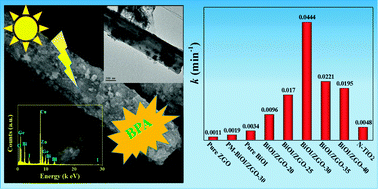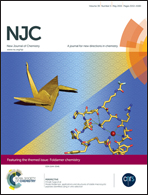Facile synthesized highly active BiOI/Zn2GeO4 composites for the elimination of endocrine disrupter BPA under visible light irradiation
Abstract
A simple chemical bath approach for the facile synthesis of a BiOI/Zn2GeO4 composite has been demonstrated. The as-prepared samples were characterized by X-ray diffraction (XRD), scanning electron microscopy (SEM), transmission electron microscopy (TEM), high-resolution transmission electron microscopy (HRTEM), X-ray photoelectron spectroscopy (XPS), and UV-vis diffuse reflectance spectroscopy (UV-vis DRS). The XRD results indicate that the BiOI and Zn2GeO4 co-exist in the composite. The HRTEM image, showing clear lattice fringes, proves the formation of a heterojunction between BiOI and Zn2GeO4. The photo-degradation of bisphenol A indicates that the BiOI/Zn2GeO4 composites are more photoactive than BiOI and Zn2GeO4. The photocatalytic activity enhancement, which is mainly ascribed to the strong sensitization of BiOI to Zn2GeO4, broadened the photoabsorption of Zn2GeO4, and the heterojunction of BiOI/Zn2GeO4 facilitated the transfer and separation of photo-generated charge carriers. In addition, the active species trapping experiments showed that h+ and ˙O2− were the dominant reactive species, while molecular oxygen plays a fatal role for photocatalytic interactions. Subsequently, a possible degradation mechanism is proposed. Furthermore, the BiOI/Zn2GeO4 photocatalysts exhibit a higher mineralization capacity for bisphenol A, suggesting hopeful prospects for its use in practical applications for the decomposition of organic pollutants.


 Please wait while we load your content...
Please wait while we load your content...